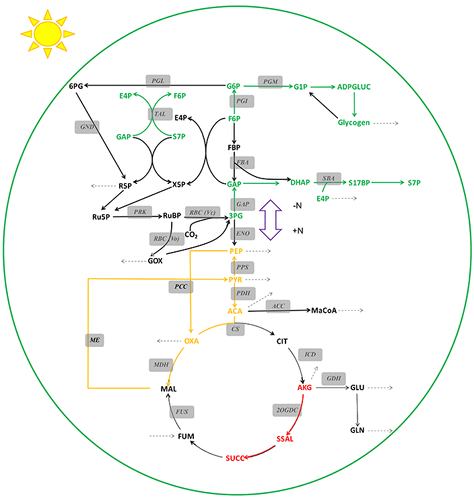当前位置:
X-MOL 学术
›
ACS Synth. Biol.
›
论文详情
Our official English website, www.x-mol.net, welcomes your
feedback! (Note: you will need to create a separate account there.)
Rerouting of Metabolism into Desired Cellular Products by Nutrient Stress: Fluxes Reveal the Selected Pathways in Cyanobacterial Photosynthesis
ACS Synthetic Biology ( IF 3.7 ) Pub Date : 2018-04-04 00:00:00 , DOI: 10.1021/acssynbio.8b00116 Xiao Qian 1 , Yuan Zhang 1 , Desmond S. Lun 2, 3, 4 , G. Charles Dismukes 1, 5
ACS Synthetic Biology ( IF 3.7 ) Pub Date : 2018-04-04 00:00:00 , DOI: 10.1021/acssynbio.8b00116 Xiao Qian 1 , Yuan Zhang 1 , Desmond S. Lun 2, 3, 4 , G. Charles Dismukes 1, 5
Affiliation

|
Boosting cellular growth rates while redirecting metabolism to make desired products are the preeminent goals of gene engineering of photoautotrophs, yet so far these goals have been hardly achieved owing to lack of understanding of the functional pathways and their choke points. Here we apply a 13C mass isotopic method (INST-MFA) to quantify instantaneous fluxes of metabolites during photoautotrophic growth. INST-MFA determines the globally most accurate set of absolute fluxes for each metabolite from a finite set of measured 13C-isotopomer fluxes by minimizing the sum of squared residuals between experimental and predicted mass isotopomers. We show that the widely observed shift in biomass composition in cyanobacteria, demonstrated here with Synechococcus sp. PCC 7002, favoring glycogen synthesis during nitrogen starvation is caused by (1) increased flux through a bottleneck step in gluconeogenesis (3PG → GAP/DHAP), and (2) flux overflow through a previously unrecognized hybrid gluconeogenesis–pentose phosphate (hGPP) pathway. Our data suggest the slower growth rate and biomass accumulation under N starvation is due to a reduced carbon fixation rate and a reduced flux of carbon into amino acid precursors. Additionally, 13C flux from α-ketoglutarate to succinate is demonstrated to occur via succinic semialdehyde, an alternative to the conventional TCA cycle, in Synechococcus 7002 under photoautotrophic conditions. We found that pyruvate and oxaloacetate are synthesized mainly by malate dehydrogenase with minimal flux into acetyl coenzyme-A via pyruvate dehydrogenase. Nutrient stress induces major shifts in fluxes into new pathways that deviate from historical metabolic pathways derived from model bacteria.
中文翻译:

通过营养应激将代谢重新路由到所需的细胞产物中:助焊剂揭示了蓝藻光合作用的选定途径
光合自养生物基因工程的主要目标是提高细胞的生长速度,同时使新陈代谢重新定向为所需的产物,但由于对功能途径及其阻滞点的了解不足,到目前为止,这些目标尚未实现。在这里,我们应用13 C质量同位素方法(INST-MFA)量化光自养生长过程中代谢物的瞬时通量。INST-MFA通过最小化实验和预测的质量同位素异构体之间残差平方的总和,从有限的一组13种C-同位素异构体通量中,确定每种代谢物的全球最准确的绝对通量组。我们表明,广泛观察到的蓝细菌生物量组成的变化,在这里用Syechococcus进行了证明。sp。PCC 7002有利于氮饥饿期间的糖原合成,其原因是:(1)通过糖异生(3PG→GAP / DHAP)瓶颈步骤的通量增加,以及(2)通过以前未认识到的混合糖异生-戊糖磷酸(hGPP)途径的通量溢出。我们的数据表明,氮饥饿下较慢的生长速度和生物量积累是由于降低了固碳速率和减少了碳通入氨基酸前体的通量。此外,13 C来自α酮戊二酸助熔剂琥珀酸证明发生经由琥珀酸半醛,替代以往的TCA循环,在聚球蓝细菌7002在光养养条件下。我们发现丙酮酸和草酰乙酸主要由苹果酸脱氢酶合成,并通过丙酮酸脱氢酶以最小的通量转化为乙酰辅酶-A 。营养胁迫会导致通量发生重大变化,从而转变为新途径,而新途径与模型细菌衍生的历史代谢途径不同。
更新日期:2018-04-04
中文翻译:

通过营养应激将代谢重新路由到所需的细胞产物中:助焊剂揭示了蓝藻光合作用的选定途径
光合自养生物基因工程的主要目标是提高细胞的生长速度,同时使新陈代谢重新定向为所需的产物,但由于对功能途径及其阻滞点的了解不足,到目前为止,这些目标尚未实现。在这里,我们应用13 C质量同位素方法(INST-MFA)量化光自养生长过程中代谢物的瞬时通量。INST-MFA通过最小化实验和预测的质量同位素异构体之间残差平方的总和,从有限的一组13种C-同位素异构体通量中,确定每种代谢物的全球最准确的绝对通量组。我们表明,广泛观察到的蓝细菌生物量组成的变化,在这里用Syechococcus进行了证明。sp。PCC 7002有利于氮饥饿期间的糖原合成,其原因是:(1)通过糖异生(3PG→GAP / DHAP)瓶颈步骤的通量增加,以及(2)通过以前未认识到的混合糖异生-戊糖磷酸(hGPP)途径的通量溢出。我们的数据表明,氮饥饿下较慢的生长速度和生物量积累是由于降低了固碳速率和减少了碳通入氨基酸前体的通量。此外,13 C来自α酮戊二酸助熔剂琥珀酸证明发生经由琥珀酸半醛,替代以往的TCA循环,在聚球蓝细菌7002在光养养条件下。我们发现丙酮酸和草酰乙酸主要由苹果酸脱氢酶合成,并通过丙酮酸脱氢酶以最小的通量转化为乙酰辅酶-A 。营养胁迫会导致通量发生重大变化,从而转变为新途径,而新途径与模型细菌衍生的历史代谢途径不同。











































 京公网安备 11010802027423号
京公网安备 11010802027423号